|
Bullfrog, Rana catesbeiana
|
| The bullfrog, Rana catesbiana, is found throughout North America east of the Rocky Mountain. Bullfrogs are typically green or greenish brown, of light or dark shade. The back and sides may be plain in color or may be spotted with dark. When present, the spots may be distinct or connected. The arms and legs are spotted or barred with dark. Underparts are white, distinctly or obscurely spotted and mottled with dark. The throat of the male may be yellow. The iris is either golden or reddish bronze. |
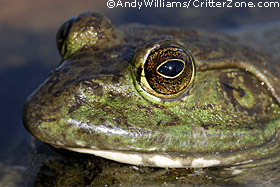 Bullfrog, Rana catesbeiana
Bullfrog, Rana catesbeiana
|
| Large in size, both male and female bullfrog often reach a body length of 6 to 8 inches. The leg to the heel is not as long as the combined lengths of head and body. The femur is about equal to the tibia. A bullfrog's head is broad and flat. The body is stout and flat. The ear of the male is much larger than the eye; while the ear of the female is about the size of the eye. A strong fold of skin extends from behind the eye to the arm, curving around the ear. Toes are broadly webbed with no joints free, except the last of the fourth toe. |
| The bullfrog is America's largest frog; however, size is not a good criteria to judge the age or gender of the amphibian. The variation in this aspect of them is amazing. A frog one year old may be no more than two inches long. Much depends on the size attained by the tadpole before the transformation. Much of a bullfrog's growth also depends on food and other environmental conditions. The bullfrog is generally a solitary animal except during breeding season which runs from late May into July. |
| Although bullfrogs have a broad and flat head, the head of an immature frog is slightly less broad than the adult. The color varies greatly, not just by gender, but also among individuals of the same gender. The bullfrog has power to change color considerably. The general color of the upper parts is dull olive green, marked with irregular, dusky spots of brown. However, when the frog is in warm air and exposed to bright light, the skin may become a beautiful spotless yellow green, very light in tone. A bullfrog just from the mud or deep water is so dark colored that it appears nearly black. |
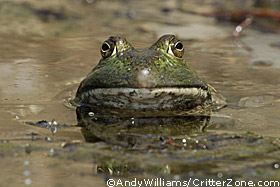 Bullfrog, Rana catesbeiana
Bullfrog, Rana catesbeiana
|
| Experiments prove that variation in light has much to do with these color changes when temperature and moisture conditions remain steady. The female is usually more brown and spotted, and the male more nearly plain green. The under parts of both are white, with distinct or indistinct mottlings of brown. The male has a bright yellow throat; that of the female is dirty white, mottled with brown. This description holds true regarding the bullfrog of northeastern North America, but may vary regionally. |
| A bullfrog's eyes are surprisingly small and little elevated, giving it an expression lacking in intelligence. In this frog the vocal sacs of the throat extend backward over the arm so that when the frog croaks, not only does the throat swell, but pouches appear between the ear and the arm similar to the leopard frog. The female croaks in a manner similar to that of the male, but without quite the same force and without the appearance of pouches at the sides of the head. |
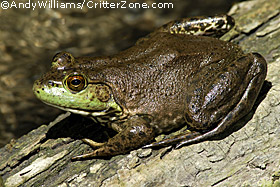 Bullfrog, Rana catesbeiana
Bullfrog, Rana catesbeiana
|
| The common bullfrog is a powerful swimmer, with strong, long back legs that may measure from seven to ten inches and having very large webbed feet. It is interesting to see one dive underwater. The legs are straightened powerfully, and then slowly drawn forward into position for the second stroke. The huge web is alternately extended into a flat resisting membrane and folded again as the leg is drawn forward. The eyes are shut by being lowered in their sockets, or flattened, until they are level with the head. This takes the eyes out of danger during the swift motion through the water, but also makes a short distance travelled necessary. The frog must stop or slow down and open it's eyes to see where it is or if an enemy is near. The frog, like the toad, has no outer ear to slow down swimming. The ear drum is at the surface of the head, covered and protected only by the moist skin. When a bullfrog dives, large bubbles of air are given off from the nostrils, which are then closed tightly. The frog does not use its lungs for breathing underwater as its nostrils are kept closed. Instead, the frog's moist skin is like a great gill stretched over its entire body. As a consequence of this attribute, the frog not only can live underwater for months at a time, but will also spend a very large portion of the time lying at the bottom of the pond. They use the same skin breathing technique for hibernation while resting in the mud at the bottom of ponds during winter. |
| Bullfrogs are late to come out of hibernation. It may not be until late May that we hear their deep bass voices uttering something that sounds like "jug a rum...jug a rum...more rum." They prefer large ponds or lakes, where they can find deep water as well as shallow. Their favorite ponds are screened from the shore by low willows, alders, cattail, or other water-loving plants. They like these places because of the sheltering growth of water-lilies and other plants that make good hiding places. Much of a bullfrog's dinner menu resides on or under these plants and leaves. |
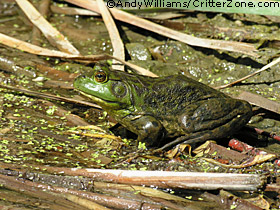 Bullfrog, Rana catesbeiana
Bullfrog, Rana catesbeiana
|
| They like to eat crayfish, water beetles, snails and dragonfly larvae, but this doesn't account for the bigger items on the menu. They like to eat fish, small turtles, young water birds, and even other frogs! The bullfrog will eat any moving object that it can swallow or partially swallow. It does not take long to discover the cannibalistic traits of this frog. It's not a good idea to keep a large bullfrog in the same place with smaller frogs as they will soon disappear. |
| The bullfrog differs from the leopard frog in that it doesn't hunt in any place except the body of water which it lives. The bullfrog is more thoroughly aquatic in its feeding habits. However, if you happen to be walking cross-country during a long, heavy rain, you could see a large bullfrog out and about. Whether the continued wet weather has tempted the frog to go hunting beyond its usual home, or whether it's migrating from one pond to another, would be difficult to say. |
| Adult bullfrogs can generally leap about three feet, but are able to cover a distance of five or six feet without difficulty. A wet bullfrog leaping across a dry surface leaves curious tracks, interesting in that they show how large a part of the under portion of the body and thighs strikes the ground forcibly after each leap, and how the frog "toes in" with its front feet. |
| A tame bullfrog will always sing when other sounds are being produced, whether these are musical or not, and they always becomes enthusiastic at the sound of running water. The bullfrog has two internal vocal sacs, which act as resonators. These are in the pouch of the throat, and the openings into them are on the floor of the mouth. When the frog croaks, the yellow throat over the vocal sacs and the sides of the body in the region of the lungs are forcibly distended with air drawn in through the nostrils. The throat and sides immediately relax as air passes out over the vocal cords of the throat, and sound is produced. |
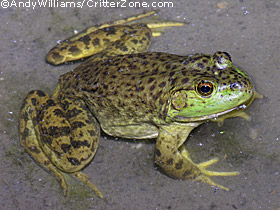 Bullfrog, Rana catesbeiana
Bullfrog, Rana catesbeiana
|
| Giant bullfrog tadpoles can be found any month in the year, but June and July are when most of the final transformations are made. Bullfrog tadpoles do not develop into frogs during the first season, as do those of the leopard frogs. It is not until the second season, and sometimes the third, that a bullfrog tadpole makes its final transformation. |
| The tadpole has no means of defense, and depends completely on hiding or flight for survival. Fortunately, they are well equipped for both. The marbled speckled brown of the tadpole's moist skin makes it almost invisible on the muddy pond bottom. Its long tail has a broad fin with strong muscles. Using its tail, the tadpole can swim rapidly and vigorously, sloshing silt around, and obscuring its intended course. On the left side of the tadpole is a conspicuous opening, the breathing pore. Tadpole breathing is done by means of internal gills on each side of the throat, in a position like that of a fish's gills. |
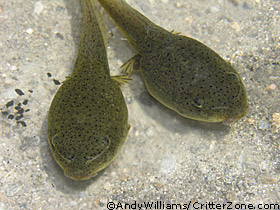 Bullfrog tadpoles, Rana catesbeiana
Bullfrog tadpoles, Rana catesbeiana
|
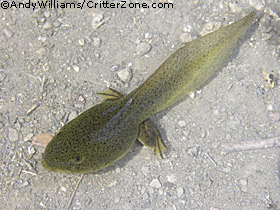 Bullfrog tadpole, Rana catesbeiana
Bullfrog tadpole, Rana catesbeiana
|
| They are concealed by the outer skin which grows back from the sides of the head in the young tadpole and covers the external gills. There are three sets of internal gills resembling feathery tufts on each side. Thus, the tadpole is able to breathe underwater. One important way in which the tadpole is fitted to cope with adversity is the ability to regrow its tail. If a hungry fish bites it off, another grows in its place. In a sense, a tadpole "eats" its own tail, though not in the customary manner of eating. |
| The process of absorption includes the tail retreating into the body of the tadpole which helps in the formation of new organs. The wandering white blood corpuscles (phagocytes) accomplish this retreat of the tail substance in such a manner that the external skin of the tail is not broken. Nothing of this process except the result is visible from the outside. These corpuscles move out into the tail and carry the particles one by one into the body to serve as food for the tadpole. The decrease in size of the tail proceeds rapidly until there is a mere black stub left, and our tadpole no longer looks like a tadpole, but like a fully formed frog. The skin is more distinctly mottled, and the coloring around the eyes and nose is green and iridescent. The eyes are more elevated, showing rounded black centers surrounded by a broad iris, reddish gold in color. The mouth is open to a point on a line with the back of the eye. The lines where the membrane of the gill-chambers joined with the body wall are still visible around the arms. |
| It is not until four days later that the ear membrane is visible, and at that point the the tail is entirely gone. The frog begins to show hiding and burrowing habits. In fact, young frogs at this stage remain concealed underwater, mud, or moss most of the time, except at night. During the first summer the young bullfrog eats insects of all sorts, but by fall it is capable of disposing of small fish. |
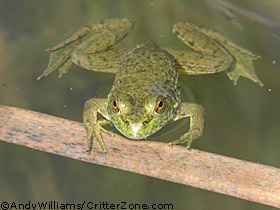 Bullfrog, Rana catesbeiana
Bullfrog, Rana catesbeiana
|
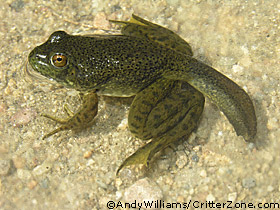 Bullfrog with tail, Rana catesbeiana
Bullfrog with tail, Rana catesbeiana
|
| The final adult bullfrog is alert in vision and hearing, ready for a sudden movement at any second. If a dragonfly skims over the water's surface in front of it, the insect is swallowed quickly. If a sparrow comes for its daily bath beside what seems to be a moss-covered stone, its brown tail feathers are seen a moment later protruding from the frog's mouth. However, it is not appetite alone that brings the bullfrog's alert senses into play. A heron hunting bullfrogs has no chance of catching one on the bank. It's only when the bullfrog is underwater in the mud that it's caught unsuspecting by the heron's beak, or by the stealthy slither of it's main enemy, the snake. |
The call of the bullfrog brings to mind warm summer nights, and childhood days spent eagerly trying to catch and observe their tadpoles. For centuries this creature has brought enjoyment to the inhabitants of North America. With enough proper habitat provided for them, hopefully bullfrogs will continue to thrive for centuries to come.
Andy Williams / CritterZone.com
|
The frog pictures and bullfrog photos on this page are available for commercial stock photography license. All photos and text that appears on this webpage is copyrighted and may not be copied or used in any way without permission from CritterZone. You can view more bullfrog photos in our online gallery:
bullfrog, Rana catesbeiana, stock photos
CritterZone does not specifically endorse our advertisers, or their methods. We cannot control the ads that run on our articles. CritterZone advocates humane and respectful treatment of all creatures. |
Save this page:

|